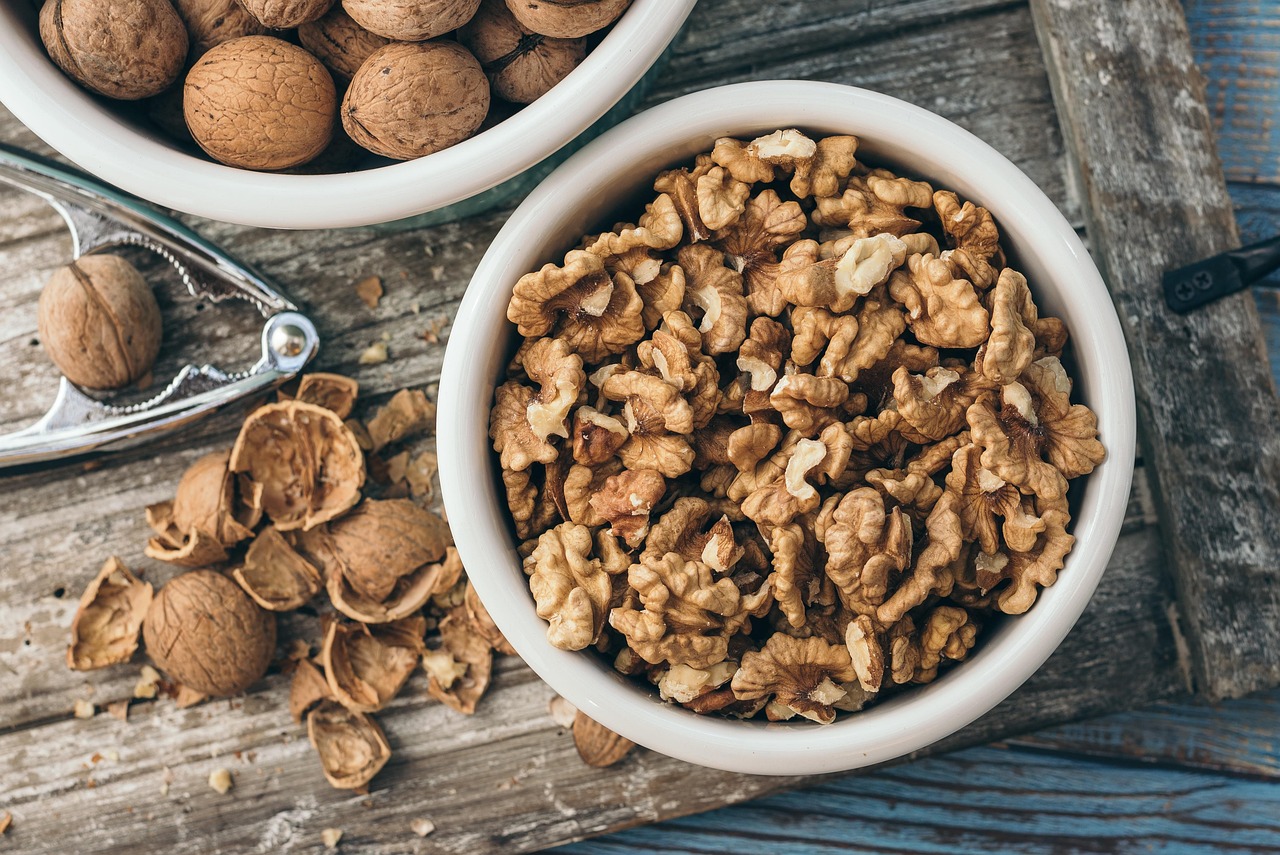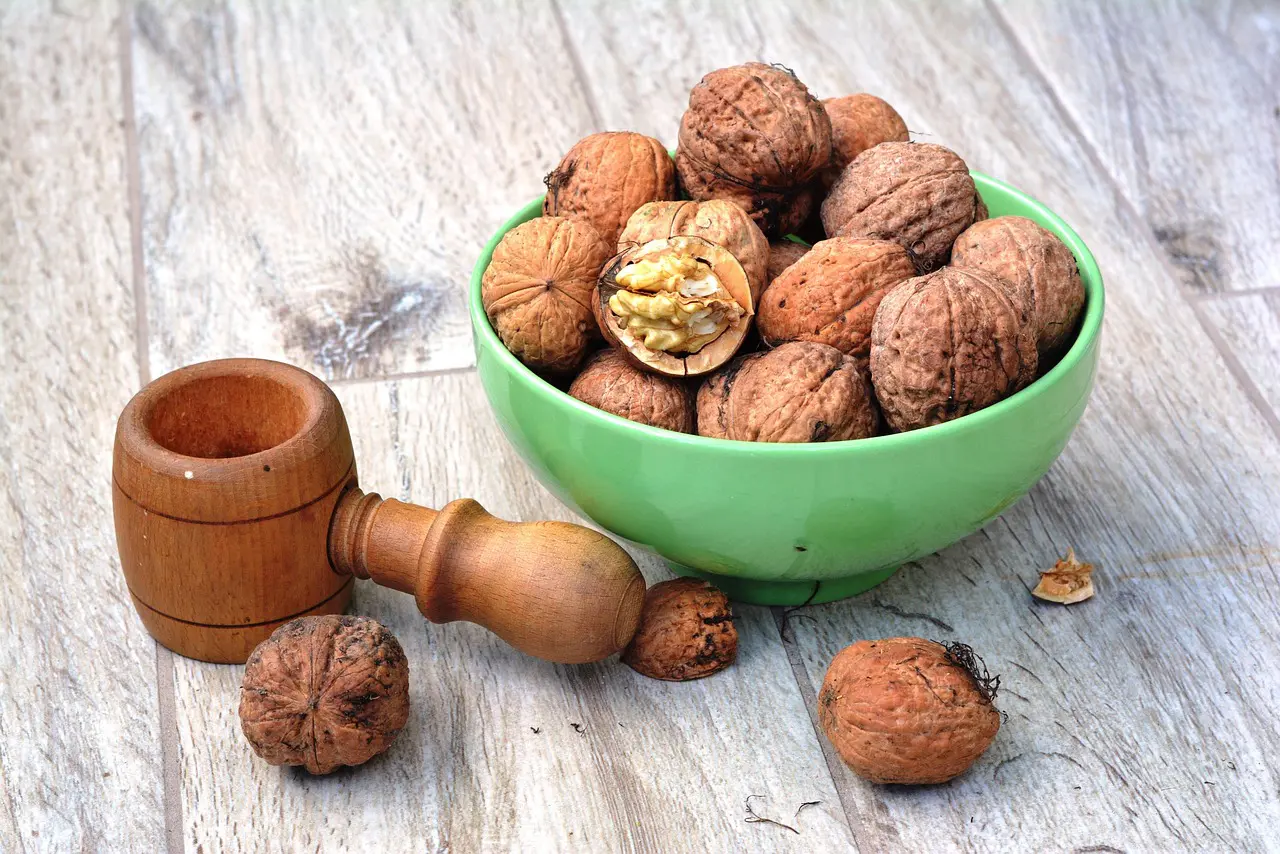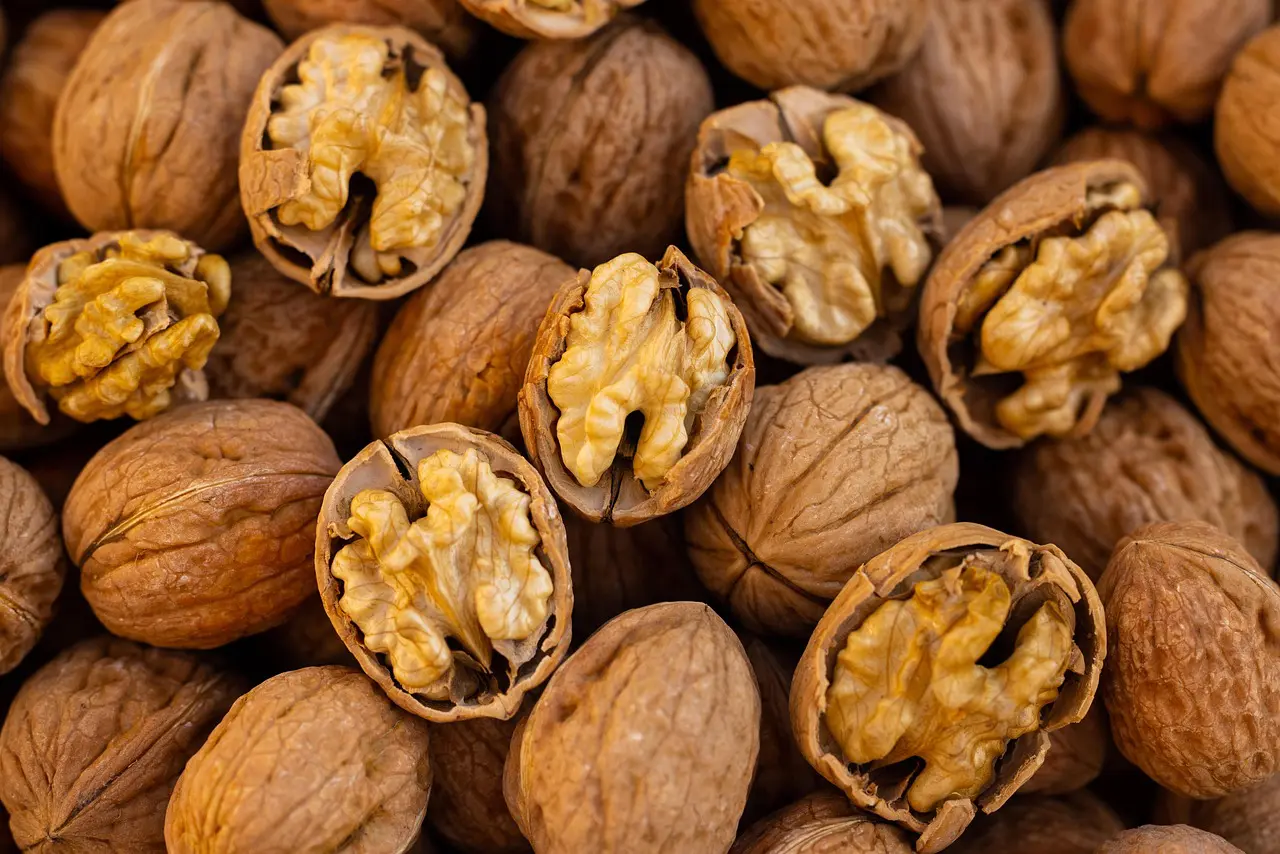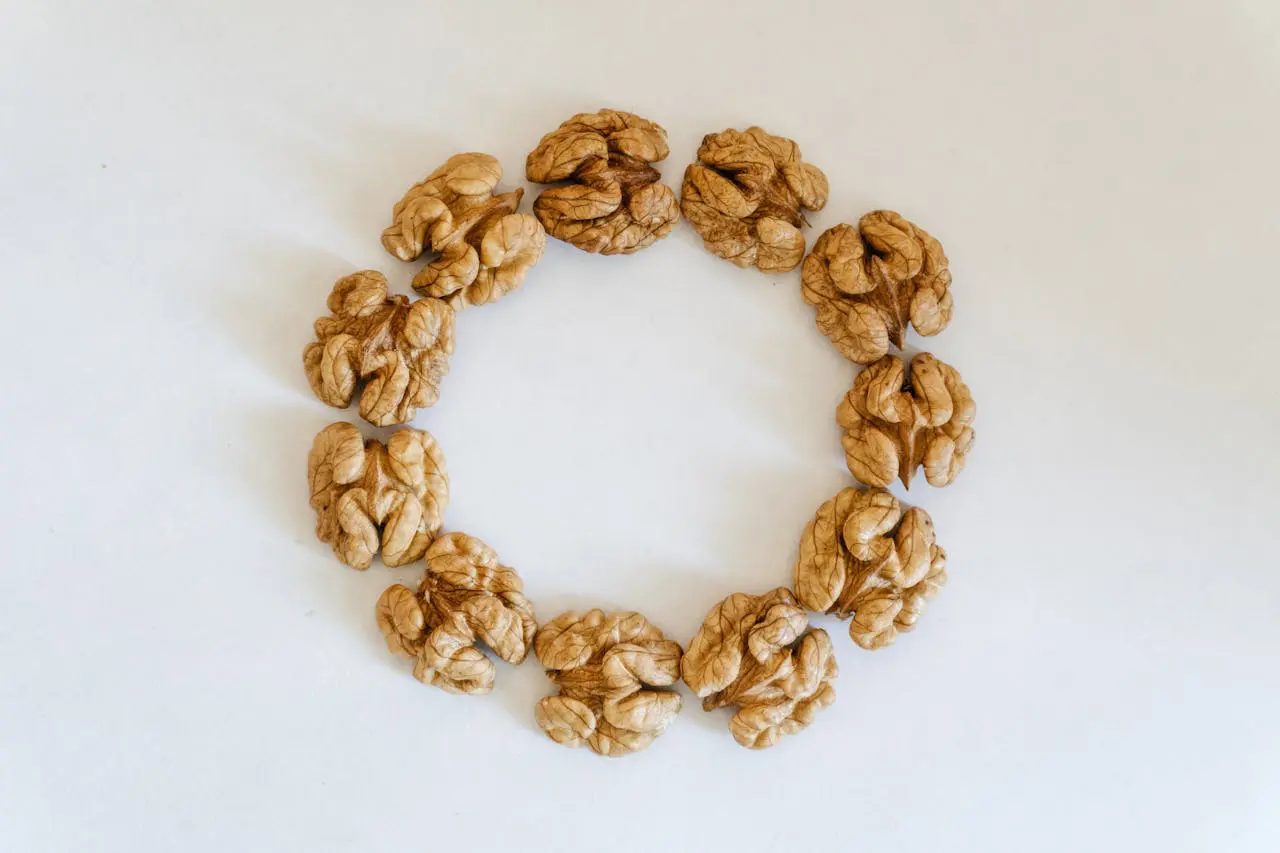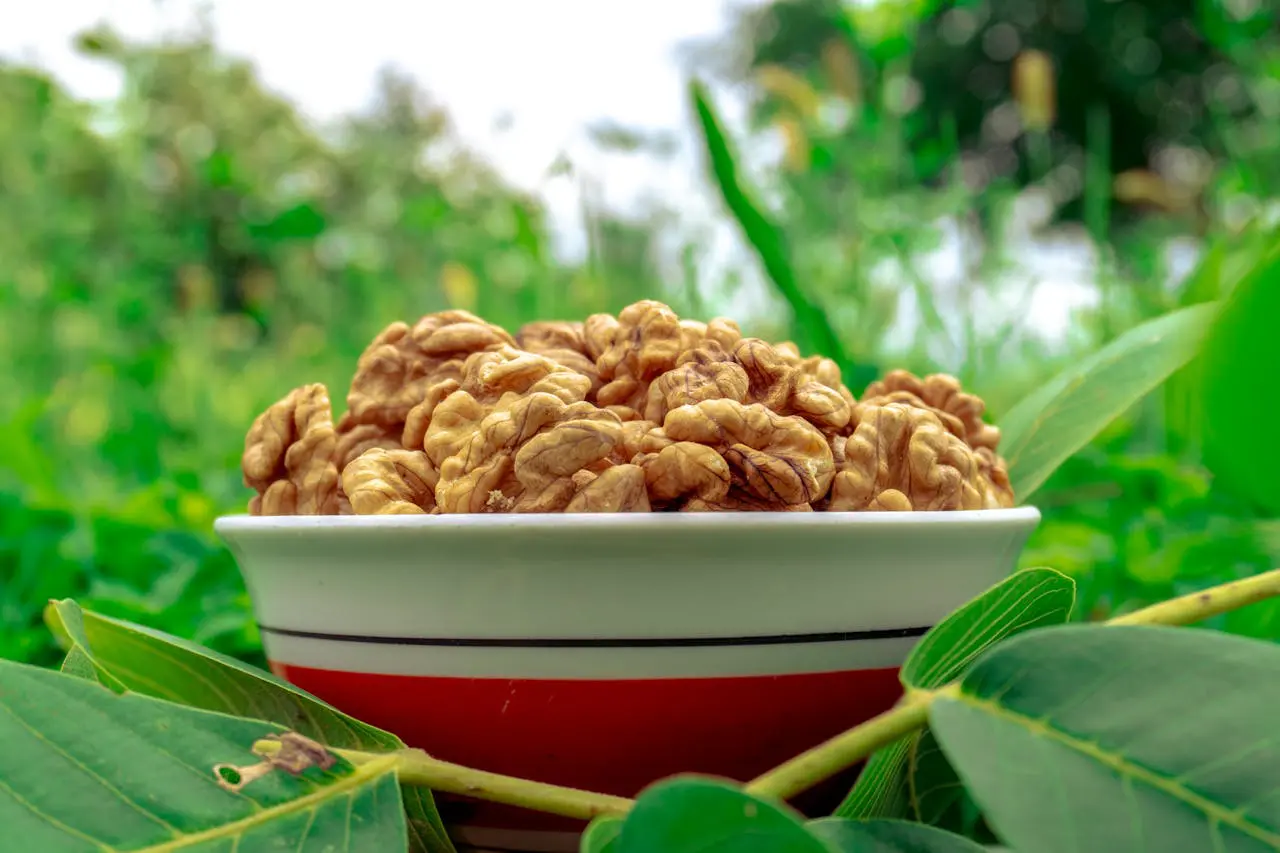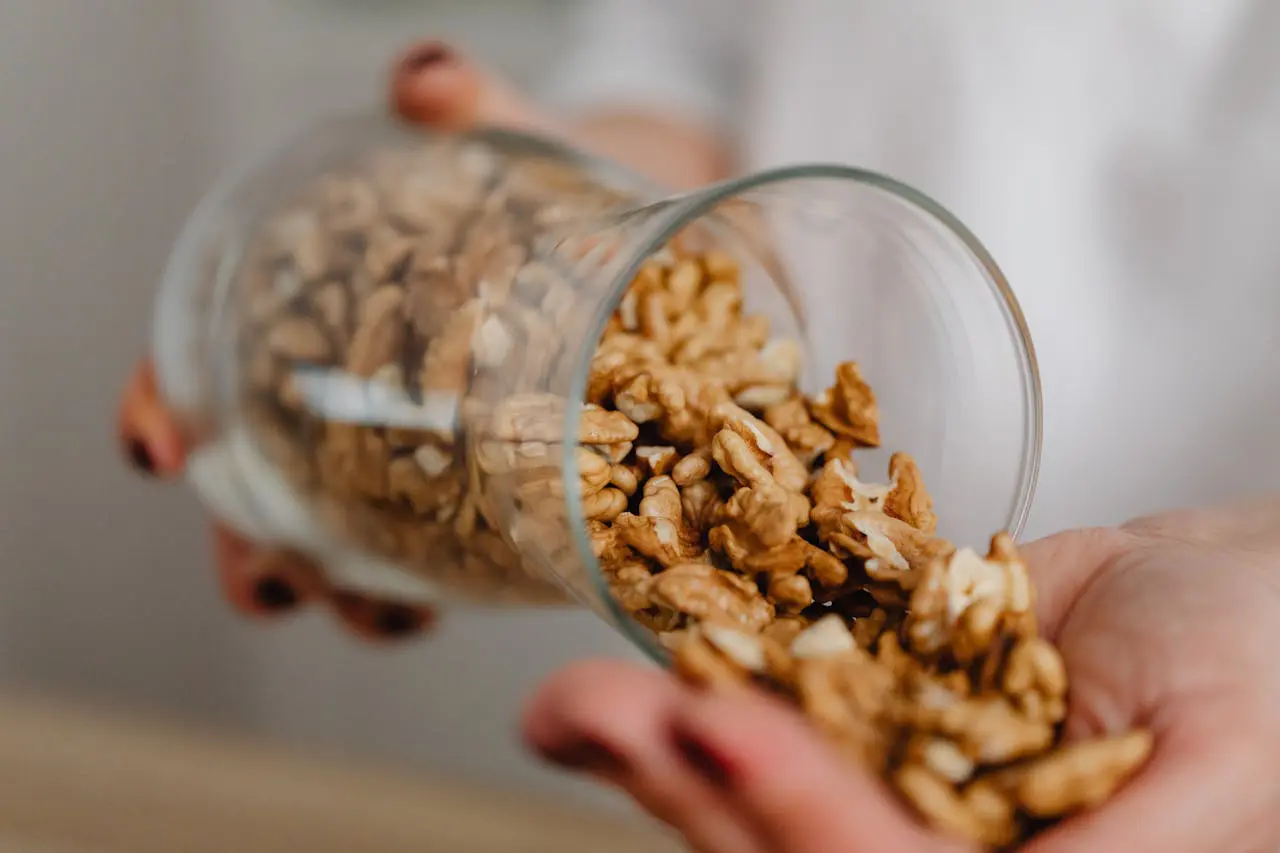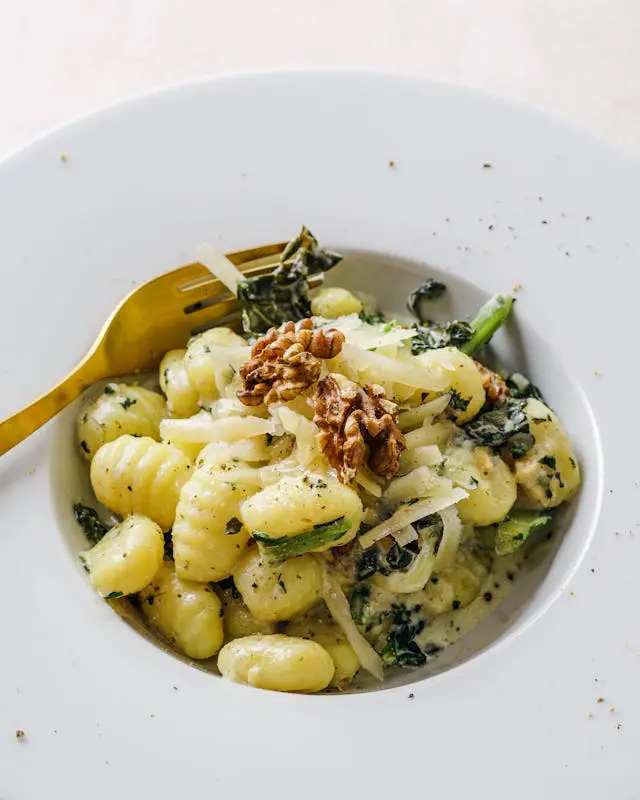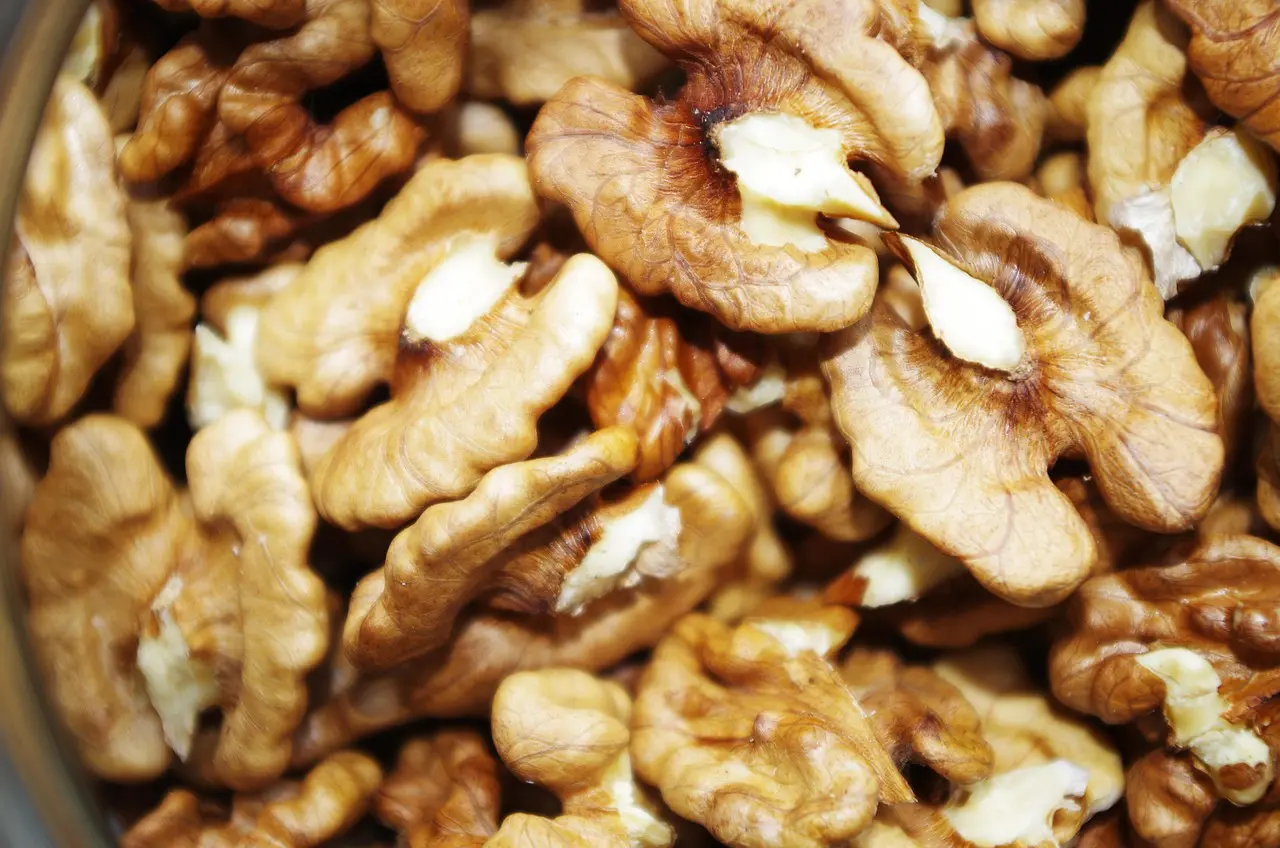Most of us have heard some version of “you should eat a handful of walnuts a day, they’re good for you.” It sounds like generic health advice – the same category as “drink water” and “get sleep.” (and, if you are like me, you are tired of hearing this type of generic advice.) But in the case of walnuts, there’s unusually solid science behind that advice.
Walnuts are one of the most studied nuts when it comes to heart health, blood lipids (especially LDL cholesterol), vascular function, gut bacteria, and even brain aging. They’re also one of the only nuts that consistently show benefits in human trials where real people actually ate walnuts daily and doctors measured what changed in their bodies.
You’ll see that below – I’m linking directly to peer-reviewed studies, systematic reviews, and guidance from institutions like the American Heart Association, the U.S. Food & Drug Administration, and the NIH so you can check every claim for yourself.
I’m going to walk you through:
- why walnuts are different from other nuts,
- what they actually do in the body (heart, brain, gut, weight),
- what the early cancer data really means (and doesn’t mean),
- how many walnuts a day makes sense,
- and who should not eat walnuts or should be careful.
Because I pay attention to weight gaining, at the end you will see a very practical “how to add them without secretly adding 300 calories” section – because, yes, I know that they are high in calories.
Let’s start with what makes walnuts special in the first place.
Why walnuts are not “just another nut”
First, because I always hate it when I do not know what a handful of something means, let’s see what that means when referring to walnuts.
A small handful of walnuts – about 1 ounce / 28 grams / roughly 12–14 walnut halves – gives you around (and this is what makes walnuts special):
- ~185–190 kcal,
- ~18 g of fat (mostly polyunsaturated, not saturated),
- ~4 g protein,
- ~2 g fiber,
- and about ~2.5 g of ALA (alpha-linolenic acid), which is a plant-based omega-3 fat your body can’t make on its own.
You can confirm these numbers in the USDA FoodData Central database for “walnuts, English, 1 oz,” which is considered the standard reference for nutrition data in the U.S. (https://ods.od.nih.gov/factsheets/Omega3FattyAcids-Consumer/).
That last bit – ALA – is the big differentiator.
Among tree nuts, walnuts stand out as one of the most concentrated plant-based sources of the omega-3 fatty acid alpha-linolenic acid (ALA). According to the Harvard T.H. Chan School of Public Health’s Nutrition Source, walnuts are listed among the nuts with the highest ALA content.
Since ALA is an essential fatty acid – meaning you must obtain it through your diet – walnuts become an especially useful choice for those who eat little or no fish. Your body can convert some ALA into the longer-chain omega-3s EPA and DHA, but that conversion is limited, so getting ALA directly from foods matters.
Beyond ALA, walnuts also bring polyphenols (plant antioxidants), arginine (an amino acid that supports nitric oxide production for blood vessel relaxation), fiber, and minerals. So they’re not just “healthy fat.” They’re more like a little cardiovascular toolkit.
Now let’s talk results. What happens in actual humans who eat walnuts regularly?
Heart health and cholesterol: this is where walnuts shine the most
If you only remember one benefit of walnuts, make it this: they are good for your heart.
For example, a meta-analysis of 13 randomized controlled trials (365 participants) observed that walnut-supplemented diets resulted in an average LDL-C reduction of ~9 mg/dL versus control.
In a 2-year randomized trial of older adults, daily walnut consumption lowered LDL-C by ~4.3 mg/dL and reduced small, dense LDL particles, which are more atherogenic.
Walnuts and LDL (“bad”) cholesterol
LDL cholesterol tends to get most of the blame for heart disease because high LDL can contribute to plaque building up in arteries. As I saw mine was elevated, I wanted to find out if, apart from the medical treatment I received, there is any way I can improve my eating habits (I received a dietary plan too – with foods to avoid, etc.)
A 2022 systematic review and meta-analysis found that walnut intake led to improvements in blood lipids, including lower total cholesterol and LDL cholesterol in humans. That supports the idea that walnuts could be part of a strategy to reduce cardiovascular risk over time.
I also found a very cool long-term trial that the American Heart Association has written about: older adults ate walnuts daily for two years. At the end, the walnut group had modest but statistically significant reductions in LDL cholesterol and LDL particle number compared to the control group, which is considered meaningful because LDL particle number is linked to cardiovascular risk.
Does that mean walnuts are a cholesterol drug? No. But does it mean daily walnut intake, in a normal human diet, can create measurable improvements in LDL – the same LDL your doctor nags you about on bloodwork? Yes.
Walnuts and your blood vessels (endothelial function)
Cholesterol is not the whole story. The inside lining of your arteries (the endothelium) is like a smart, reactive surface that controls blood flow, blood pressure, and inflammation. When that lining works better, that’s good.
In a classic randomized crossover trial published in the journal Circulation, people with high cholesterol followed two different versions of a Mediterranean-style diet. One version specifically included walnuts as part of the fat source.
The walnut version significantly improved endothelium-dependent vasodilation – in plain English, their blood vessels relaxed and responded better – and this improvement could not be fully explained just by changes in cholesterol alone.
Other controlled studies that swapped saturated fats (like high-fat dairy or certain meats) for walnuts and similar plant fats have also reported benefits in things like central blood pressure and vascular tone – basically, how “stiff” or “relaxed” the arteries are under pressure.
So walnuts don’t just move your numbers. They also seem to help your vascular system behave more like that of a healthier person.
Why do walnuts do this?
There are a few mechanisms researchers talk about in review papers:
- ALA omega-3 helps reduce inflammation and may contribute to improved endothelial function.
- Polyphenols and vitamin E–like compounds in walnuts act as antioxidants.
- Arginine supports nitric oxide, which helps blood vessels dilate.
- Replacing saturated fat with walnuts can drop LDL and improve LDL particle quality.
Reviews that look at human trials connect these mechanisms to actual clinical markers like flow-mediated dilation (a test of how well your arteries relax) and to lower levels of certain adhesion molecules linked to inflammation and atherosclerosis.
Where official organizations land on this
The U.S. Food and Drug Administration (FDA) actually allows a qualified health claim on nuts (including walnuts). The FDA’s position – and I’m going to quote the logic, not the marketing – is that “supportive but not conclusive” research suggests that eating 1.5 ounces (about 42 grams) of most nuts per day, such as walnuts, as part of a diet low in saturated fat and cholesterol, may reduce the risk of coronary heart disease. The important fine print: those nuts should replace foods higher in saturated fat, and you’re not supposed to just pile nuts on top of everything else and call it healthy. This letter is an interesting and relevant read.
The American Heart Association also lists unsalted nuts (including walnuts) as part of a heart-healthy eating pattern and points to evidence that daily walnut consumption lowered LDL cholesterol and LDL particle number in older adults over two years.
In the European Union (as I am from a European country, I always check data form my continent too), health-claims regulation is managed by EFSA. In its Scientific Opinion on walnuts (2011), EFSA found sufficient evidence to approve a health claim that a daily intake of 30 g of walnuts may improve endothelium-dependent vasodilation (i.e., blood-vessel relaxation), but it did not approve a claim for reduction of blood LDL cholesterol on its own (EFSA pdf here).
As a result, in EU member states, walnuts may be promoted for vascular benefits under that claim, but the regulatory wording is stricter than some U.S. wording, requiring specified conditions (e.g., amount, diet context).
In Asian dietary contexts, while there may not be a single unified regulatory “heart-health nut claim,” national cohorts and guidelines increasingly recommend nuts. For example, Korean cohort data (2024) show that consuming 15-30 g of nuts per week was associated with a 34 % lower risk of cardiovascular-disease mortality among Korean adults.
Brain and cognitive aging: interesting, but not magic
There’s a two-year randomized trial called WAHA (Walnuts and Healthy Aging) that looked at whether adding walnuts to the diet of older adults would preserve thinking skills. The headline: overall cognition didn’t significantly improve across all participants. (a complete article is here)
So “eat walnuts and never forget your keys again” is not evidence-based.
But – and this is where nuance matters – the same trial did find some signals in subgroups. People with higher cardiovascular risk factors and people with lower baseline education (which is sometimes used as a proxy for higher dementia risk later in life) seemed to get more cognitive or brain-structure benefit from walnuts. Brain imaging in part of the group suggested walnuts might help slow certain forms of brain decline in people who are already at higher risk.
How do we interpret that? Here’s the way I understand it:
There is not enough evidence to say walnuts “boost memory.”
There is enough evidence to say walnuts fit into an overall brain-supportive pattern, mostly because they improve vascular health (blood flow to the brain matters), and they’re a source of ALA and antioxidants that may reduce neuroinflammation.
So yes, walnuts can be part of your “healthy aging” diet – just don’t treat them like a nootropic supplement.
Walnuts and the gut microbiome (your internal ecosystem)
This is one of the most underrated benefits.
In a controlled human feeding study (meaning the researchers actually provided the food, which makes the data cleaner), adults who ate walnuts showed measurable shifts in their gut microbiota.
Specifically, they had increased levels of bacteria known for producing butyrate (like Faecalibacterium and Roseburia), and a decrease in certain secondary bile acids that are considered more pro-inflammatory and have been linked to metabolic problems.
Why do we care about butyrate? Butyrate is a short-chain fatty acid that helps keep the lining of the colon healthy and may play a role in reducing systemic inflammation.
The same study also observed improvements in LDL cholesterol in some participants, suggesting there may be a gut-cholesterol connection happening here.
In normal-person language: walnuts seem to “feed” bacteria we like to see more of, in a direction that’s associated with healthier metabolism and lower inflammation. That doesn’t mean walnuts cure IBS or heal your gut overnight, but it does mean the walnut/gut story is not hype — it’s visible in real adults eating real food.
Blood sugar, insulin, and metabolic health
Let’s address something that matters for a lot of people: do walnuts help with blood sugar control?
When researchers pulled together data from controlled trials and ran a systematic review/meta-analysis (think: strongest form of evidence short of a giant multi-year trial), they found that walnuts did not significantly change fasting glucose or other standard markers of glycemic control across the board.
So: walnuts are not a blood-sugar hack.
But here’s the nuance again. People who eat walnuts tend to have better overall cardiometabolic profiles (lower LDL, better vascular function, better gut profile).
Observational studies (these are population studies that look at patterns, not cause-and-effect) have linked walnut eaters with a lower risk of type 2 diabetes, but observational links are not proof. People who eat walnuts also tend to do other healthy things. We can’t “blame” the walnuts alone for the effect.
What feels fair and honest to say is this: walnuts work well in eating patterns that are already good for blood sugar, like Mediterranean and DASH-style diets. They’re especially helpful when they replace refined carbs (white pastries, chips, sweet snacks) or replace sources of saturated fat. But you should not think of walnuts as medication for glucose. They’re more of a “support player” for long-term metabolic health.
“But aren’t nuts super fattening?” – the weight question
Let’s talk calories, because this is the point where a lot of people stop listening and go “nope, too many calories, can’t.” Frankly, this is a very important element for me too, so I researched this thoroughly.
Walnuts are calorie-dense. One ounce is around 185–190 calories. That’s not nothing.
However – and this is the part most people don’t realize – when researchers actually test whether adding nuts causes weight gain, the answer, over and over, is mostly no.
Multiple randomized controlled trials (the gold standard in nutrition research) and large prospective cohort studies (people followed over time) show that including nuts like walnuts does not lead to significant weight gain. In some cases, nut eaters gain less weight over the long term compared to non-nut eaters.
Why? A few reasons have been proposed in these papers:
- Nuts are filling. People naturally compensate by eating a bit less later.
- Not all the calories from nuts are absorbed; some of the fat stays trapped in the nut matrix and literally passes through you. So the “label calories” may slightly overstate what your body actually absorbs.
- People who snack on nuts are often replacing ultra-processed, high-sugar, high-refined-carb snacks – and those swaps matter.
There’s also evidence that nuts can fit into calorie-restricted diets without slowing weight loss. In other words: you can be actively trying to lose weight and still include a portion of walnuts daily, as long as you treat them as part of your calories, not an “extra” on top (see weight-loss and nut-inclusion trials discussed in MDPI journals and PMC-indexed reviews; search “energy-restricted diet walnuts weight loss trial”).
So walnuts are not a free food – portion still matters – but the old “nuts make you fat” rule is outdated.
Walnuts and cancer: where the research is, and where it is not
This is probably the most sensitive topic and the easiest one for the internet to distort, so let’s be very clear. And I am writing this after seeing articles on a recent study I am sharing below.
A small pilot human trial looked at women who had confirmed breast cancer. Between their diagnostic biopsy and their surgery (this is usually a gap of a couple of weeks), one group ate about 2 ounces of walnuts per day. Researchers then analyzed the tumor tissue. The women who ate walnuts showed changes in gene expression inside the tumor that suggested more activation of apoptosis (programmed cell death) and less activation of pathways linked to tumor growth and spread.
That’s fascinating. It means compounds in walnuts may influence tumor biology in living humans, not just in a petri dish.
BUT. (Big but.)
This study was very small. It ran for only about two weeks. It did not look at tumor shrinkage. It did not measure survival. It did not track recurrence rates years later. The authors themselves describe it as preliminary and say larger, longer trials are needed.
So the responsible takeaway is: walnuts appear to have bioactive compounds that may affect cancer-related gene expression in breast tissue, which is promising and worth more research. Walnuts are absolutely not a cancer treatment and should never replace medical care.
If you ever see “Walnuts kill breast cancer cells” without context, that’s someone overselling early data.
How many walnuts per day are actually useful?
Most of the human studies that showed benefits used something in this range: about 28 g (1 ounce) up to 42 g (1.5 ounces) of walnuts per day.
For reference:
- 28 g – 1 ounce is roughly 12–14 walnut halves.
- 42 g – 1.5 ounces is closer to a very full small handful.
That 1–1.5 oz range shows up in:
- trials on cholesterol and vascular function,
- the WAHA trial in older adults,
and it’s literally the amount mentioned in the FDA’s qualified heart health claim for nuts and coronary heart disease risk: 1.5 oz/day, as long as you’re not just adding that on top of a high-saturated-fat diet.
Two important notes here:
It only “works” in context. You don’t get the same benefit if breakfast is pastries, lunch is fast food, dinner is cheese and salami, and then you go, “It’s fine, I ate walnuts.” The best outcomes happen when walnuts replace a less healthy fat or a processed carb.
Calories still count. One ounce of walnuts is ~185–190 kcal (USDA FoodData Central). You can absolutely fit that into a normal day. What you don’t want to do is mindlessly snack through half a bag.
If you like a visual rule: pre-portion your walnuts. Don’t eat them from the giant bag.
Who should NOT eat walnuts (or should be careful)
Most healthy adults can safely eat walnuts daily, but not everyone should just dive in.
1. People with tree nut allergies (or suspected allergies)
Walnuts are a tree nut. Tree nut allergies can cause serious reactions, including anaphylaxis. If you know you’re allergic to walnuts – or even if you only know you’re allergic to “some nuts” – do not experiment casually. Talk to an allergist first. The American College of Allergy, Asthma & Immunology and patient resources like FoodAllergy.org are very clear: nut allergies can be severe, and cross-contact is common during processing and packaging.
2. Young children (whole nuts are a choking risk)
Whole nuts are considered a choking hazard for young children. Guidance from the UK National Health Service (NHS) says whole nuts shouldn’t be given to children under 5 years old; smooth nut butters or very finely ground nuts are safer options in appropriate amounts.
So: no whole walnut halves for toddlers.
3. People who have been told to follow a low-oxalate diet for kidney stones
If you’ve had certain types of kidney stones (calcium oxalate stones), your doctor may have mentioned “oxalates.” Walnuts contain a moderate amount of oxalates – roughly in the tens of milligrams per serving, though numbers vary by source and testing. Some clinical nutrition guidance suggests pairing higher-oxalate foods with calcium-containing foods (like yogurt) so more oxalate binds in the gut instead of getting absorbed.
This does not mean “no walnuts for kidney stone patients.” It means “talk to your nephrologist/dietitian about your personal oxalate limit and portion sizes.”
4. People with IBS on a low-FODMAP plan
If you’re doing a strict low-FODMAP diet (often used short-term for IBS under dietitian supervision), portion matters. Monash University’s FODMAP guidance (the program that basically created the low-FODMAP approach) generally lists something around ~10 walnut halves (about 30 g) as low-FODMAP for most people, but tolerance is personal.
If you know nuts bother you, introduce them slowly.
5. Anyone actively restricting calories who is prone to “healthy snack creep”
This is more behavioral than medical, but it’s real. Walnuts are healthy, yes. They’re also energy-dense.
If weight loss is a goal, you can 100% keep walnuts in – there are even trials showing that including nuts in a calorie-reduced diet doesn’t block weight loss, and in some cases improves satiety and adherence.
However, you need to budget for them. A “handful here, handful there, plus my usual snacks” can quietly add 300–400 calories.
6. Surgery / bleeding risk / medications
There’s a common internet myth that “if you eat walnuts (or other omega-3 foods) you’ll bleed too much in surgery.”
Here’s what the evidence actually says: walnuts contain ALA. The main bleeding-risk warnings you’ve probably heard are about high-dose fish oil supplements that deliver large amounts of EPA/DHA, not about normal food portions.
Major medical organizations and the NIH Office of Dietary Supplements do not flag normal walnut intake as a bleeding risk for most people (NIH ODS Omega-3 Fact Sheet).
If you’re on prescription anticoagulants or you’re about to have surgery, always follow your surgeon’s actual instructions – but walnuts at standard dietary amounts are not generally treated like a drug.
How to add walnuts in a way that actually helps you (and doesn’t just pile on calories)
Here’s how people in the studies tended to eat walnuts – and how you can steal those habits.
Swap part of something, don’t just add
For example, instead of cheese + croutons on your salad, do a sprinkle of chopped walnuts and skip the croutons. You just replaced refined carbs/saturated fat with polyunsaturated fat, fiber, and ALA.
That’s the exact kind of “exchange” that improved cholesterol and blood vessel function in the Circulation trial and similar studies.
Stir them into breakfast
Add walnuts to plain yogurt, oatmeal, or overnight oats. You’ll get fiber, protein, crunch, and the fats that keep you full, instead of relying on sugary granola clusters.
Trials exploring nuts and weight consistently point out that nuts increase satiety, which helps with calorie control later in the day (multiple RCTs and cohort data summarized in BMJ Nutrition, Prevention & Health and on PubMed Central / PMC: search “nut consumption satiety weight gain prevention”).
Use them in bowls and grain salads.
Walnuts + beans or lentils + leafy greens + olive oil + vinegar = a very Mediterranean, very cardiologist-approved lunch. Diet patterns like this – high in plant fats, fiber, and polyphenols – are the same patterns repeatedly associated with lower LDL and better vascular markers.
Bake smarter
If you bake banana bread, carrot muffins, etc., add a modest amount of chopped walnuts, but also cut some of the sugar and replace part of the butter with yogurt or fruit purée.
The goal is not “banana cake plus walnuts.” The goal is to upgrade the overall nutrient profile.
Pre-portion your snack
Seriously, do this. Take a small container or bag and count out ~12–14 walnut halves (~1 oz). That’s your daily serving.
If you’re someone who snacks when you’re stressed, that pre-portioned bag is the difference between “heart-healthy habit” and “accidentally ate 600 calories of nuts.”
Store them right
Walnuts go rancid faster than, say, almonds, because they’re higher in polyunsaturated fats.
Keep them sealed, in the fridge or freezer, not sitting open in a warm pantry.
Rancid nuts = off taste and degraded fats.
So… should you start eating walnuts every day?
If you are not allergic to tree nuts, are not dealing with a very specific medical restriction (like a tightly controlled low-oxalate plan), and you can manage the portion, the answer for most adults is honestly: yes, walnuts can be a daily habit.
Here’s what you’re realistically getting from about 1 ounce (28 g) to 1.5 ounces (42 g) of walnuts a day:
- Better LDL cholesterol numbers and healthier LDL particle profiles, based on long-term human trials.
- Better blood vessel function (endothelial responsiveness), which matters for long-term cardiovascular risk, and has been shown in randomized controlled feeding studies in Circulation and other AHA journals.
- A friendlier gut microbiome profile – more butyrate-producing bacteria, fewer inflammatory bile acids – demonstrated in controlled human feeding research.
- No automatic, unavoidable weight gain, as long as walnuts are treated as a swap, not a constant extra.
- Walnuts deliver ALA, an essential omega-3 that’s especially valuable if you don’t eat fish.
One last, important thing: the early breast cancer study showing changes in tumor gene expression after two weeks of eating walnuts is scientifically exciting and 100% worth more research, but it is still early. Walnuts are not a cancer cure and should never replace medical treatment!
Disclaimer
This article talks about what researchers observed at the population and clinical trial level. It’s not personal medical advice or medical adive of any kind. If you have a tree nut allergy, a history of kidney stones, IBS/IBD, are feeding a toddler, are on a medically restricted diet, or you’re on medication with bleeding or clotting implications, talk to your own doctor or registered dietitian before making big diet changes .
If you’re generally healthy? One small handful of walnuts a day – about 12 to 14 halves – is one of the simplest, most evidence-backed upgrades you can make to support your heart, your blood vessels, and possibly even your gut, without turning your entire diet upside down.
And that’s something worth eating for.
Read my other articles that will help you live a healthier, longer life:
- Scientists Reveal the Unexpected Longevity Habit That Costs Nothing
- Scientists Say This Overlooked Habit Could Add Years to Your Life
- Scientists Say People With This Mindset Are Far More Likely to Reach Age 90+
- Add Decades, Not Just Years: 8 Habits That Could Add 20–25 Years to Your Life (Backed by a Massive Study)
- Want a Longer, Happier Life? Scientists Say This 1-Hour Habit Could Be the Key
- Want to Live Longer? Studies Say These Mental Habits May Help (No Sweat Required)
- Eat Earlier, Live Longer? What a New Study Says About Breakfast Timing, Aging, and Longevity
- Simple daily habits for a healthier mind
- How to De-Clutter Your Mind, Backed by Science
- The Personality Traits That Can Help You Live Longer (and Be Happier)
- How to Build Real Self-Esteem That Lasts (Backed by Science, Not Buzzwords)
- 17 Signs You Are Happier Than You Think
- 11 Signs You Are More Intelligent Than You Think
- Things People With High Self-Esteem Rarely Do
- How to Reduce Sugar Intake Naturally
- Science-Backed Benefits of Eating Walnuts (and How Much You Should Actually Eat)
Frequently Asked Questions About the Health Benefits of Walnuts
1. Are walnuts really good for your heart?
Yes. Multiple clinical trials and meta-analyses have shown that walnuts can help lower LDL (“bad”) cholesterol and improve blood vessel function. These effects are linked to their high content of ALA omega-3s, polyphenols, and antioxidants. Eating about 1 ounce (28 g) of walnuts a day as part of a balanced diet supports cardiovascular health.
2. How many walnuts should I eat per day for health benefits?
Most research suggests that 1 to 1.5 ounces (28–42 g) daily – around a small handful or 12–14 walnut halves – provides the benefits without adding excess calories. The American Heart Association and FDA both recommend nuts like walnuts in moderate, daily portions as part of a heart-healthy diet.
3. Can eating walnuts help with weight loss?
Surprisingly, yes – when they replace less healthy snacks. Randomized controlled trials show that including walnuts in a calorie-controlled diet does not cause weight gain and may even improve satiety (feeling full). The key is to swap, not add: replace chips or pastries with walnuts.
4. Are walnuts good for brain health and memory?
Walnuts are rich in omega-3 ALA and antioxidants, which may support brain and cognitive function. The WAHA (Walnuts and Healthy Aging) trial found potential benefits in brain structure among older adults at higher risk of decline. While walnuts aren’t a “memory pill,” they contribute to long-term brain wellness.
5. Can walnuts improve gut health?
Yes. A controlled human feeding study published in The Journal of Nutrition found that walnut consumption increased beneficial gut bacteria such as Faecalibacterium and Roseburia, which produce butyrate – a compound linked to gut and immune health.
6. Who should not eat walnuts?
Avoid walnuts if you have a tree-nut allergy, and keep whole nuts away from small children (choking risk). People with kidney stones or IBS should discuss portion sizes with their doctor or dietitian. Walnuts are safe for most people when eaten in moderation.
7. Do walnuts thin your blood or cause bleeding before surgery?
No. The bleeding risk warnings mainly apply to high-dose fish oil supplements, not normal walnut consumption. Walnuts contain ALA omega-3s, which have not been shown to increase bleeding at typical food intakes. Always follow your doctor’s advice before surgery.
8. Can diabetics eat walnuts?
Yes. A 2020 meta-analysis found that walnuts do not raise fasting glucose or worsen glycemic control. In fact, they fit well in diabetes-friendly diets like the Mediterranean or DASH pattern – especially when they replace refined carbs or saturated fats.
9. Are roasted walnuts as healthy as raw ones?
Both are nutritious, but lightly roasted walnuts retain most nutrients and flavor. Avoid heavily roasted or salted varieties, since excess heat or sodium can reduce benefits. Raw or dry-roasted walnuts are best for long-term health.
10. Can I eat walnuts every day?
Absolutely. Daily walnut consumption is supported by research for heart, brain, and gut benefits. Just keep portions moderate (1–1.5 oz) and store them in a cool, dark place or the fridge to protect their healthy oils.
Photo sources: 1, 2, 3, 4, 5, 6, 7, 8, 9

